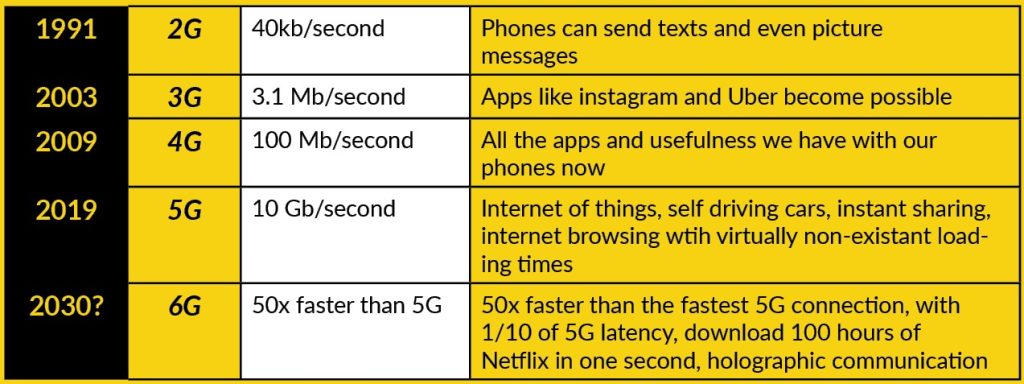A 6G enabled world will take the advances that 5G has allowed us a peek at, such as virtual reality, augmented reality, Ultra High Density video, haptic communications, 3D communications and autonomous driving, and make them ubiquitous.
Currently, with 5G radios capable of several hundred megahertz of bandwidth, we have sufficient ability to drive the drive the audio and video we need for our user applications, but networks just ten years in the future will require several gigahertz of bandwidth to perform optimally. This bandwidth does not exist contiguously below 90 GHz, but these blocks are readily available in the higher spectrum bandwidth, specifically in the terahertz (THz) frequency band.
It is this terahertz frequency that 6G is predicted to utilise to improve performance of the data rate and latency limitations.
Every ten years or so, wireless generations are standardised by the International Telecommunications Union and generally they are marked by a change in transmission or coding.
It is usual for subsequent wireless generations to use more advanced digital encoding that older devices are unable to do.
This utilises areas of bandwidth that governments are only just releasing for use, and to use new antenna systems that previously could not be engineered.
As consumers, we see these jumps in wireless generations in terms of what our mobile devices can do, and how fast they can do it.

Taking autonomous vehicles as an example of how 6G will build on 5Gs foundations, currently we see steps are being made using 5G to allow cars to make independent decisions and to respond to situations and driving emergencies.
Whilst it is technically possible to utilise 5G to allow cars to make autonomous decisions based on their surroundings, and to communicate and cooperate with one another, the huge amounts of bandwidth required for them to become ubiquitous rules out 5G.
Universally used autonomous vehicles would give rise to the scenario of thousands of self driving cars all driving on a motorway, miles away from a city.
Each car needs to be able to react to hazards in an instant, so the connection drop for even a split second, or there would be multiple collisions as the vehicles lose their intelligence of their surroundings.
What is needed is a reliable connection which is fast enough to process the data from each car instantly, serving to make such advances commonplace.
This amount of bandwidth will be possible within the Terahertz frequency bands.
High-frequency terahertz waves can otherwise be described as ‘submillimetre waves’. They are radio waves which fall into the spectrum of 300GHz to 10THz (terahertz), and are what 6G is predicted to use.
Terahertz waves are a much higher frequency than the millimetre waves utilised in 5G technology, and as such they are expected to solve the coming network congestion and bandwidth limitation issues.
6G’s use of higher frequency terahertz waves will provide substantially more capacity and micro-second latency, but they may bring with them limitations.
The fast speeds and low latency currently utilised by 5G need ‘line of sight’ between the transmitter and the user. As wavelengths get shorter, transmission can be impeded further by environmental obstructions (like buildings and trees), but also by water vapour in the Earth’s atmosphere, which is a strong absorber of terahertz radiation.
This will limit the range of THz applications, and it is this same issue that continues to slow the widespread development of 5G. New networking approaches will need to be harnessed to overcome this same range issue with THz waves.
Whilst some of 6G’s expected applications just iterate those that 5G enables and make them faster and more reliable, one new application that 6G terahertz band communication is expected to introduce is in the field of holographic communications.
High end applications using holographic image transmission, such as holographic interactive entertainment, holographic conferences, holographic social networking and holographic navigation will become possible.
In their 6G white paper, Samsung suggest they expect 6G will enable ‘volumetric holograms’, requiring at least 580Gbps for a phone sized display, and several terabits per second of data for human sized holograms. Going forward, Samsung raises the idea of ‘digital twins’; people, objects and places which are fully replicated digitally, enabling users to “explore and monitor the reality in a virtual world, without temporal or spatial constraints”. Duplicating just one metre squared area in real time would be expected to need 800 Gbps, which is well beyond 5G’s capacity.
6G is clearly in its very early development stages, but we are beginning to see a roadmap which will guide the industry to the next generation of mobile communications. There are obstacles to overcome along the way, but 6G promises hitherto unseen speed and ultra low latency which will transform the way people, and objects, communicate.
Radio Design Ltd Registered Office – 37 Albyn Place, Aberdeen, AB10 1YN Registered In Scotland – No. 328828
Fill out the form below and we will contact you as soon as possible
Fill out the form below and we will contact you as soon as possible